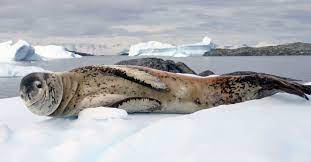
Leopard Seal
This seal is the second largest (after the southern elephant seal) to be found in the Antarctic ocean. It has a wide ranging diet, which includes cephalopods, other pinnipeds (i.e. seals and similar) krill, fish, cephalopod and birds with a specific interest in penguins; indeed unlike other members of the seal family, leopard seals also feed on other marine mammals. Most commonly, they may eat crabeater seals, Weddell seals, and Antarctic fur seals. Indeed, the leopard seal is considered an apex predator, with the ability to control populations of various species. Its only predator is the Orca, and large sharks.
It was first scientifically described in 1820. While naturally found only around Antarctic, they have been noted to wander as far as New Zealand and Australia. Except pups with their mother, they live solitary lives, and are thought to number 220,000 to 440,000.

Being large hunters, they can pose danger to humans, though attacks on humans are rare.
They live for up to 26 years, and are thought currently relatively stable as a species, though their reliance on the ice floes around Antarctica may prove a threat to the species if climate change continues unabated for some time further.
It is well worth seeing this species, and we hope to list places where you might actually find them in the wild. Do get in touch for us to add your guiding/boating or whatever, which will allow people to see this species in the wild










